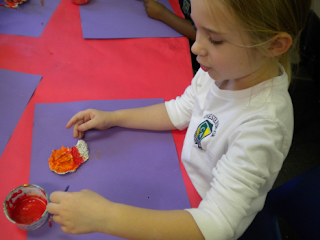The students named this painting: "The garden of hope".
One of the students said: " I like working together with my friends because I get to use all the colors."
"Rocks, means strength" said one of the students.
This painting created the biggest mess! Leaves, paint, glue, brushes, rocks, were scattered everywhere!
One of the students named this painting: "Water lilies"
We had hard time gluing the rings. When I said: "Maybe we should not add the rings", the students said: " We like the rings, they look like suns".
We learned how to work with small brushes and nails (textruring the clay flowers).
The symbol of hope.

















































